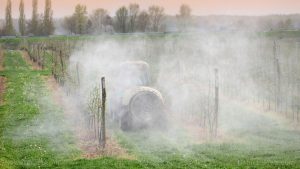Dinocap — toxicity, side effects, diseases and environmental impacts
12/05/2017 / By Janine Acero


List of known side effects
Acute exposure to dinocap may cause several adverse side effects, including:
- Abdominal pain
- Convulsions
- Diarrhea
- Dizziness
- Dehydration
- Excessive sweating
- Exhaustion
- Fatigue
- Fever
- Flushed skin
- Headache
- Heat sensitivity or heat stroke
- Hyperthermia
- Imbalance
- Loss of appetite
- Nausea
- Pulmonary edema (fluid buildup in the lungs)
- Shortness of breath
- Skin inflammation
- Sweating
- Tachycardia (rapid heartbeats)
- Tachypnea (rapid breathing)
- Thirst
- Tightness in the chest
- Vomiting
- Weakness
- Weight loss
In addition, hair and skin can be stained yellow by topical exposure to dinocap. Skin sensitization has also been reported in human subjects. Some doses are only moderately irritating to the skin and mucous membranes, except in sensitive individuals. Prolonged or repeated exposure may cause cataract formation and sometimes glaucoma.
Body systems affected by dinocap
Nitrophenols and nitrocresols like dinocap are well absorbed by the gastrointestinal tract when ingested, and by the lungs from accidental aspiration. Fatal poisonings have occurred as a result of dermal contamination.
These fungicides are toxic to the liver, kidney, and nervous system system. Death may even occur due to overheating, or failure of the respiratory system.
Items that can contain dinocap
Dinocap is applied to cherries, grapes, apples, pears, hops, pumpkins, squashes, strawberries, peppers, peaches, apricots and tomatoes. Some products also contain dinocap as an active ingredient:
- Karathane liquid
- Crotothane
- Caprane
- Ezenosan
- Mildex
- Isocothane
Manufacturers such as Landseer and Rohm & Haas supply products that contain dinocap.
How to avoid dinocap
It is advisable to avoid products that contain dinocap as an active ingredient to prevent any form of contact or exposure. Handlers, mixers and applicators of dinocap may be exposed to its fumes in the workplace. The following are some protective and preventive measures to avoid any contact with dinocap:
- Use this material only in well ventilated areas. Check with the workplace regulations on using respirators during handling of dinocap. In case of accidental aspiration, leave the area of contamination and go to an open area with fresh air or proper ventilation. Seek medical attention immediately.
- Avoid contact with skin or clothing. Wear a protective suit, chemical-resistant gloves and safety footwear or safety gumboots. Remove any contaminated clothing item carefully, avoiding any contact with the skin. Rinse the contaminated part of the skin with soap and water.
- Do not get this material in your eyes. Wearing goggles or a face shield is required before handling any chemical. In case of contact, remove contact lenses (if applicable), then rinse with running water for several minutes. Seek medical help at once.
- Do not eat, drink or smoke near this substance. In case of swallowing any amount of dinocap, give plenty of water to drink. Refer for medical attention immediately.
- Refer to the workplace regulations regarding proper handling of equipment before applying chemicals.
Where to learn more
Summary
Dinocap has been used as a contact fungicide to control fungal pathogens and even ticks and mites on apple trees.
Dinocap is applied as a foliar treatment on fruits, vegetables, nursery, and ornamentals.
Dinocap may cause several adverse side effects, and targets the liver, kidney, and nervous system system.
Tagged Under: Dinocap



















